Fencing Market Size
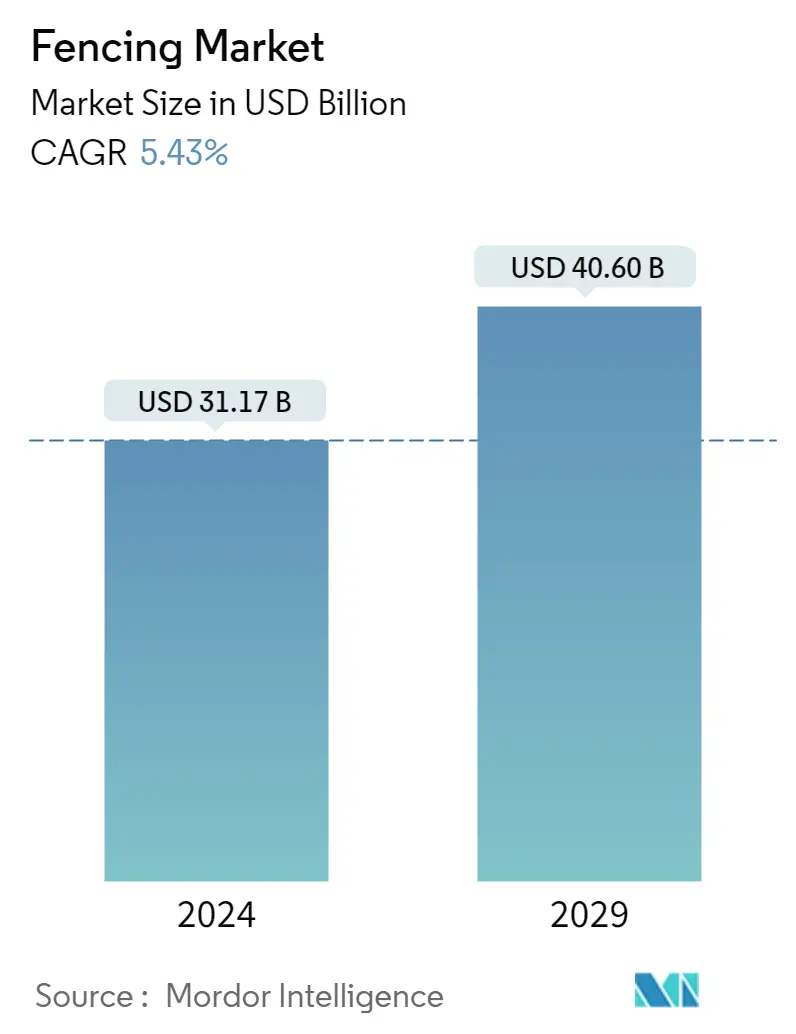
| Study Period | 2020 - 2029 |
| Market Size (2024) | USD 31.17 Billion |
| Market Size (2029) | USD 40.60 Billion |
| CAGR (2024 - 2029) | 5.43 % |
| Fastest Growing Market | North America |
| Largest Market | North America |
Major Players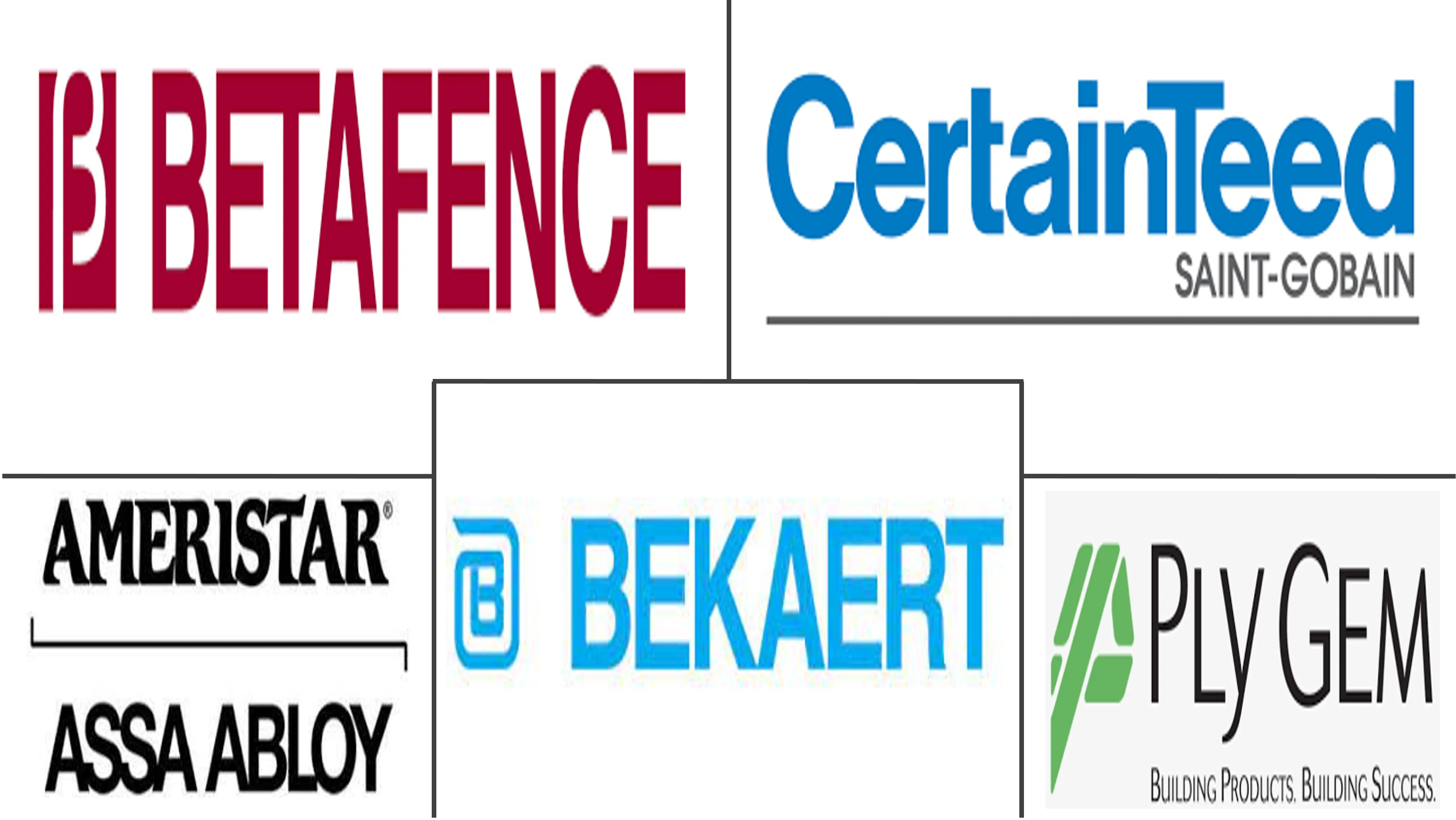
*Disclaimer: Major Players sorted in no particular order |
Fencing Market Analysis
The Fencing Market size is estimated at USD 31.17 billion in 2024, and is expected to reach USD 40.60 billion by 2029, growing at a CAGR of 5.43% during the forecast period (2024-2029).
- The surge in commercial and residential construction projects is fueling the need for fencing, prompting advancements and innovations in manufacturing to meet the rising demand for dependable and long-lasting fencing systems. Notably, the residential sector is experiencing an uptick in new builds and remodeling activities worldwide, serving as a primary catalyst for the global fencing market.
- Manufacturing firms continually strive to enhance their products to align with customer requirements, contributing to regional market growth. In North America and Europe, there's a notable emphasis on safeguarding pets and assets, bolstering protection against theft and various forms of criminal activity. Moreover, there's a considerable demand for renovation and retrofit projects throughout Europe. Government-backed initiatives prioritize cost-efficient solutions, leading to an increased preference for plastic fences.
- Asia-Pacific presents promising prospects for the fencing market, given its inclusion of rapidly developing nations like China and India, attracting considerable investor interest. However, trade disputes and economic deceleration persist in the region, particularly in China and India, where subdued domestic demand has led to reductions in investments and production across various sectors, including manufacturing.
- Military organizations often employ electric fencing to deter intrusions near international borders. Notably, China's military utilizes spiked electric wires in the Ladakh region along the disputed border with India, while the Russian military has installed electric fencing along the China-Russia border for protection. The growing focus on national security is expected to drive market growth, as electric fencing not only deters unauthorized human entry but also prevents wildlife encroachment, significantly enhancing farm safety. However, the market expansion is hindered by the substantial maintenance costs associated with electric fencing, which require regular inspections for optimal performance. Alternative solutions, such as unmanned crossings, are being explored to address these challenges and mitigate high fixed costs.
- The fencing market is segmented into three categories based on applications: industrial, agricultural, and residential. Residential construction and remodeling activities are driving the expansion of the residential segment, supported by rising disposable incomes and the increasing importance households place on security and privacy. Furthermore, there is a growing demand for distinctive fences to enhance the aesthetic appeal of residential properties. In the agricultural sector, rapid growth is anticipated due to the need to protect farms, crops, and livestock from wildlife and theft. This increased demand for agricultural fencing is driven by rising instances of agricultural intrusions, leading to the customization of fences according to customer specifications and the use of high-quality raw materials.
Fencing Market Trends
The Fencing Market in North America is Witnessing the Highest Growth Rate
- North America's residential safety and security sector is witnessing a notable uptick in consumer demand, driving its growth. Simultaneously, the region's emphasis on enhanced home aesthetics and a surge in residential construction projects are poised to bolster the market in the coming years. Notably, the agricultural sector's increasing preference for wood fencing is pivotal in propelling the North American wood fencing market.
- This surge in demand is further fueled by a rising trend among consumers, particularly the affluent and younger demographics, who seek innovative fencing solutions. On the other hand, consumers with varying income levels are gravitating towards wood fencing for privacy and security. Local manufacturers hold the lion's share in the North American market, with national and international players following suit. To stay ahead, industry leaders are prioritizing technological and design innovations.
- In North America, players are also actively pursuing M&A acquisitions to expand their market reach, while international players are eyeing local competitors. While major manufacturers in North America primarily sell directly to end-users through online platforms, wood fencing sales predominantly occur through offline channels, leveraging the influence of distributors and retailers.
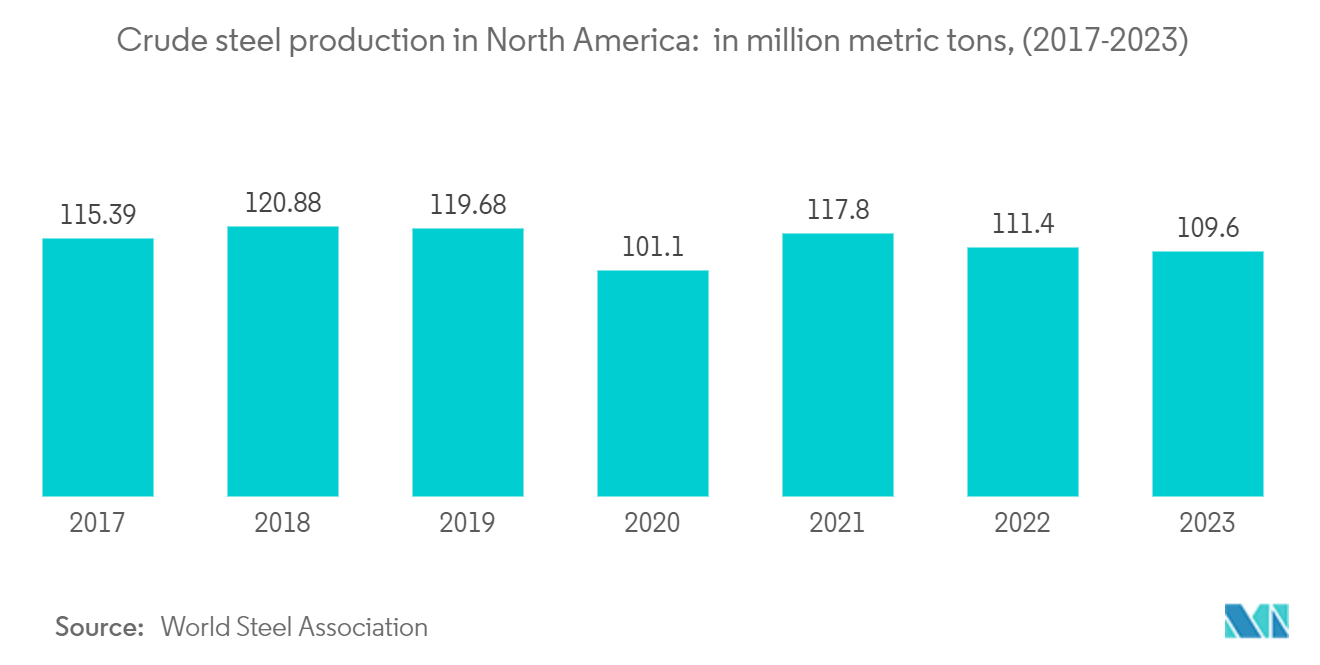
Increasing Real Estate Construction Driving the Market
- In 2023, as privacy was predicted to be a major issue, more customers chose board-on-board fences. This design uses vertically overlapping boards to block the view of a yard or house and keep off prying eyes. Similar to a slatwall, a stockade fence is made of long, flat wooden planks that are placed one on top of the other to form a plank wall. In addition to privacy concerns, this type of fencing is once again becoming popular because it was so uncommon to see it outside of rural areas. In 2023, more homeowners wanted to update their fences using cost-effective, eco-friendly fencing materials. As sustainability became more important, bamboo, biocomposite materials, and natural shrub/hedge barriers were expected to witness an increase in demand.
- The rise of the middle class is helping the expansion of the fencing business. According to the European Commission, by 2030, there are likely to be 5.5 billion members of the emerging middle class. Around 87% of the growing middle-class population will be Asian. Rising home building and a rebound in building completions are driving the growth of the fencing sector. The expansion of the global fencing market is also being fueled by growth in the estate market, brought on by a rise in firms and greater investment in the construction sector. Regular inspections are necessary to ensure optimal performance, but they are challenging to carry out due to the high cost of improvements and maintenance associated with upgrading conventional electric fences. Hefty maintenance expenses hamper its growth. Farmers are seeking other solutions, like unmanned drones, to offset the high fixed costs linked with the necessity to deploy barriers over international boundaries, which may stifle market expansion.
- Rising urbanization is considerably contributing to the growth of the fence market. Urbanization is the term used to describe the widespread movement of people from rural to urban areas, which leads to higher human population densities in urban areas. Urbanization is increasing the demand for both residential and non-residential structures, which will advance the fence market. The expansion of the middle class is helping the fencing industry. Consequently, future fencing industry growth is anticipated to be fueled by rising urbanization.
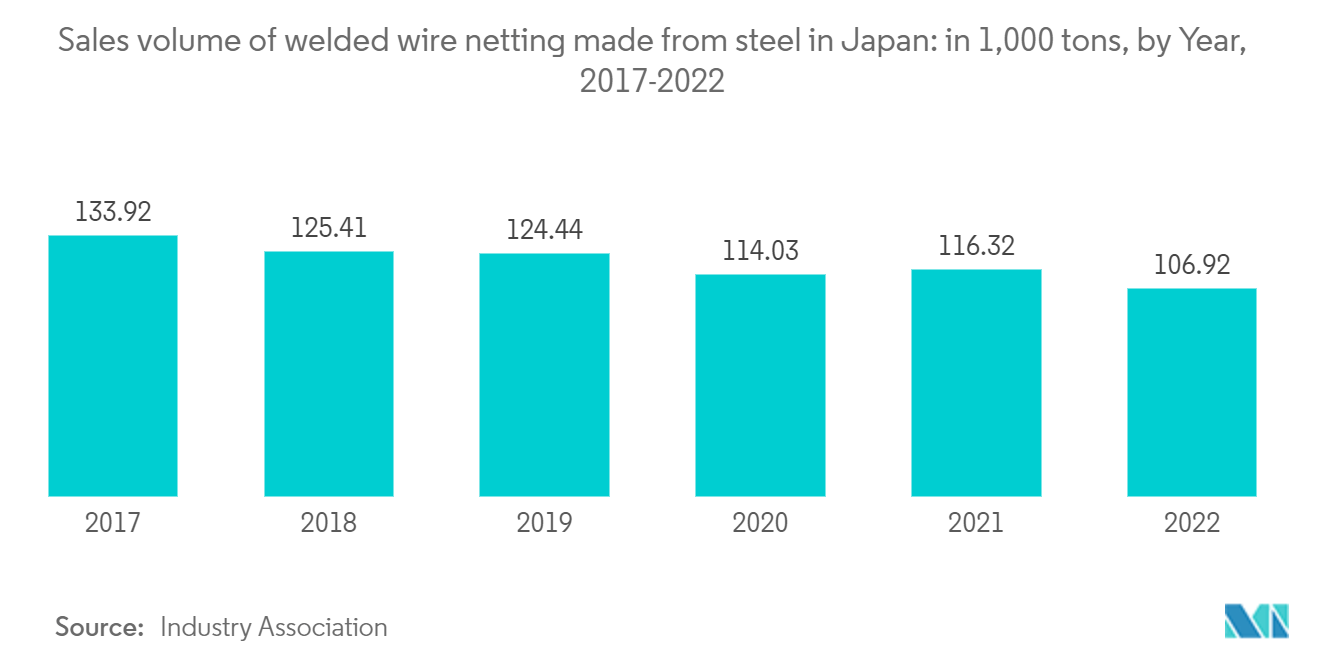
Fencing Industry Overview
The fencing market is fragmented and consists of many players. The growth of residential fencing in new construction projects is a significant driver of new opportunities for the players. The major players are CertainTeed, PLY Gem, Bekaert, BetaFence, Ameristar Perimeter Security, and many more. Growing strategic partnerships and agreements among key manufacturers for market expansion are boosting the growth of the global fencing market. The industry participants have adopted various strategies, such as new product developments, partnerships, mergers and acquisitions, agreements, and collaborations, to achieve growth in the fencing market.
Fencing Market Leaders
-
CertainTeed
-
PLY Gem
-
Bekaert
-
BetaFence
-
Ameristar Perimeter Security
*Disclaimer: Major Players sorted in no particular order
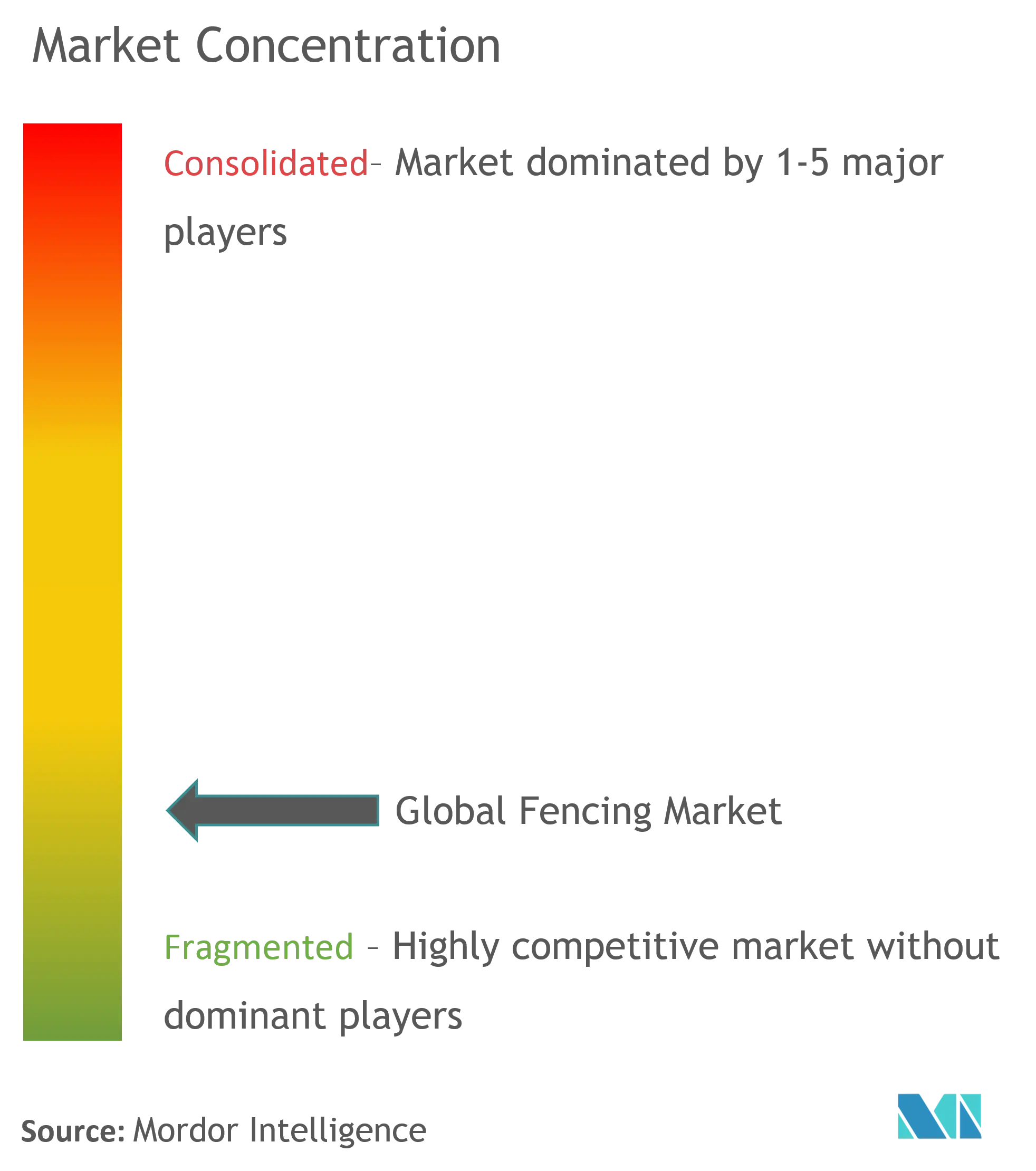
Fencing Market News
- February 2023: Crossplane Capital ("Crossplane"), a Dallas-based private equity firm, declared that it joined forces with Sal Chavarria and the company's management to purchase a controlling stake in Viking Fence, a top provider of fence rentals, sanitation rentals, fence installations, and additional building products and services to commercial and residential markets all over Texas.
- February 2023: A well-known, market-leading provider of fences and related goods and services, Phoenix Fence Corp., announced that TriWest Capital Partners had acquired a controlling interest in the company. The company will continue to be managed by the current management group at Phoenix Fence. The USD 175 million Growth Fund's sixth platform investment by TriWest is Phoenix Fence (2021 vintage).
Fencing Market Report - Table of Contents
1. INTRODUCTION
- 1.1 Study Assumptions
- 1.2 Scope of the Study
2. RESEARCH METHODOLOGY
- 2.1 Analysis Methodology
- 2.2 Research Phases
3. EXECUTIVE SUMMARY
4. MARKET INSIGHTS
- 4.1 Current Market Scenario
- 4.2 Technological Trends
- 4.3 Insights on Supply Chain/Value Chain Analysis
- 4.4 Government Regulations
- 4.5 Insights on Materials Used for Fencing
- 4.6 Impact of COVID-19 on the Market
5. MARKET DYNAMICS
-
5.1 Drivers
- 5.1.1 Government Investments in Infrastructure Projects, Such as Highways, Airports, and Railways, Often Require Fencing for Safety and Security
- 5.1.2 Advancements in Fencing Technologies, Such as Smart Fencing Systems With Integrated Surveillance and Alarm Systems, are Attracting Customers Looking for Enhanced Security Solutions
-
5.2 Restraints
- 5.2.1 Soaring Prices of Raw Material
- 5.2.2 Increasing Competition from Low-cost Products
-
5.3 Opportunities
- 5.3.1 Increasing Demand for Aesthetically Pleasing Fencing Solutions
- 5.3.2 Increasing Popularity of Eco-friendly Fencing Materials
-
5.4 Industry Attractiveness - Porter's Five Forces Analysis
- 5.4.1 Bargaining Power of Suppliers
- 5.4.2 Bargaining Power of Consumers / Buyers
- 5.4.3 Threat of New Entrants
- 5.4.4 Threat of Substitute Products
- 5.4.5 Intensity of Competitive Rivalry
6. MARKET SEGMENTATION
-
6.1 By Type
- 6.1.1 Wood Fencing
- 6.1.2 Metal Fencing
- 6.1.3 Other Types
-
6.2 By End User
- 6.2.1 Residential
- 6.2.2 Agricultural
- 6.2.3 Military and Defense
- 6.2.4 Government
- 6.2.5 Petroleum and Chemicals
- 6.2.6 Mining
- 6.2.7 Energy and Power
- 6.2.8 Warehouse
- 6.2.9 Other End Users
-
6.3 By Geography
- 6.3.1 North America
- 6.3.1.1 United States
- 6.3.1.2 Canada
- 6.3.1.3 Mexico
- 6.3.2 Latin America
- 6.3.2.1 Brazil
- 6.3.2.2 Colombia
- 6.3.2.3 Argentina
- 6.3.2.4 Rest of Latin America
- 6.3.3 Europe
- 6.3.3.1 Germany
- 6.3.3.2 United Kingdom
- 6.3.3.3 France
- 6.3.3.4 Russia
- 6.3.3.5 Rest of Europe
- 6.3.4 Asia-Pacific
- 6.3.4.1 China
- 6.3.4.2 Japan
- 6.3.4.3 India
- 6.3.4.4 South Korea
- 6.3.4.5 Rest of Asia-Pacific
- 6.3.5 Middle East and Africa
- 6.3.5.1 Saudi Arabia
- 6.3.5.2 Egypt
- 6.3.5.3 South Africa
- 6.3.5.4 United Arab Emirates
- 6.3.5.5 Rest of Middle East and Africa
7. COMPETITIVE LANDSCAPE
- 7.1 Market Concentration Overview
-
7.2 Company Profiles
- 7.2.1 CertainTeed
- 7.2.2 PLY Gem
- 7.2.3 Bekaert
- 7.2.4 BetaFence
- 7.2.5 Ameristar Perimeter Security
- 7.2.6 Long Fence
- 7.2.7 Gregory Industries
- 7.2.8 A1 Fence Products
- 7.2.9 Specrail
- 7.2.10 Jerith*
- *List Not Exhaustive
8. FUTURE TRENDS
9. APPENDIX
- 9.1 Marcroeconomic Indicators (GDP breakdown by sector)
- 9.2 Key Production, Consumption, Exports & Import Statistics
Fencing Industry Segmentation
A fence is an artificially constructed barrier of any material or combination of materials erected to enclose or screen areas of land. A complete background analysis of the fencing market, including the assessment of the economy and contribution of sectors in the economy, a market overview, market size estimation for key segments, emerging trends in the market segments, market dynamics and geographical trends, and COVID-19 impact, is covered in the report.
The fencing market is segmented by type (wood fencing, metal fencing, and other types), end user (residential, agricultural, military and defense, government, petroleum and chemicals, mining, energy and power, warehouse, and other end users), and geography (North America, Latin America, Europe, Asia-Pacific, and Middle East and Africa).
The report offers global fencing market size and forecasts in value (USD) for all the above segments.
| By Type | Wood Fencing | |
| Metal Fencing | ||
| Other Types | ||
| By End User | Residential | |
| Agricultural | ||
| Military and Defense | ||
| Government | ||
| Petroleum and Chemicals | ||
| Mining | ||
| Energy and Power | ||
| Warehouse | ||
| Other End Users | ||
| By Geography | North America | United States |
| Canada | ||
| Mexico | ||
| By Geography | Latin America | Brazil |
| Colombia | ||
| Argentina | ||
| Rest of Latin America | ||
| By Geography | Europe | Germany |
| United Kingdom | ||
| France | ||
| Russia | ||
| Rest of Europe | ||
| By Geography | Asia-Pacific | China |
| Japan | ||
| India | ||
| South Korea | ||
| Rest of Asia-Pacific | ||
| By Geography | Middle East and Africa | Saudi Arabia |
| Egypt | ||
| South Africa | ||
| United Arab Emirates | ||
| Rest of Middle East and Africa |
Fencing Market Research FAQs
How big is the Fencing Market?
The Fencing Market size is expected to reach USD 31.17 billion in 2024 and grow at a CAGR of 5.43% to reach USD 40.60 billion by 2029.
What is the current Fencing Market size?
In 2024, the Fencing Market size is expected to reach USD 31.17 billion.
Who are the key players in Fencing Market?
CertainTeed, PLY Gem, Bekaert, BetaFence and Ameristar Perimeter Security are the major companies operating in the Fencing Market.
Which is the fastest growing region in Fencing Market?
North America is estimated to grow at the highest CAGR over the forecast period (2024-2029).
Which region has the biggest share in Fencing Market?
In 2024, the North America accounts for the largest market share in Fencing Market.
What years does this Fencing Market cover, and what was the market size in 2023?
In 2023, the Fencing Market size was estimated at USD 29.48 billion. The report covers the Fencing Market historical market size for years: 2020, 2021, 2022 and 2023. The report also forecasts the Fencing Market size for years: 2024, 2025, 2026, 2027, 2028 and 2029.
Bariatric Surgery in India Industry Report
The report covers global fencing industry statistics and provides a comprehensive market analysis segmented by type, including wood fencing, metal fencing, and others. It also delves into the market segmentation by end-user sectors such as residential, agricultural, military & defense, government, petroleum & chemicals, mining, energy & power, warehouse, and other end-users. The global market overview spans across regions like North America, Latin America, Europe, Asia Pacific, and the Middle East & Africa, offering a detailed market forecast and industry outlook.
The report includes industry analysis and market trends, highlighting the market growth and market size in terms of dollars for all the segments. Additionally, it provides insights into market share and industry growth, supported by industry reports and industry research. The market data and industry statistics are crucial for understanding the market value and market predictions.
For those interested in specific industry information, the report example and report pdf offer a concise summary of the market review, market leaders, and market outlook. The research companies involved have ensured that the report is comprehensive and detailed, covering all aspects of the market segments and industry trends. The report also emphasizes the importance of industry sales and industry size in understanding the overall market dynamics.
In conclusion, this report serves as an essential resource for those looking to gain an in-depth understanding of the global fencing market, with a clear focus on market segmentation, market value, and industry trends. It is a valuable tool for making informed decisions based on the latest market data and industry outlook.



